Posts Tagged ‘Christmas’
-
THE MAGIC IS IN THE DETAIL
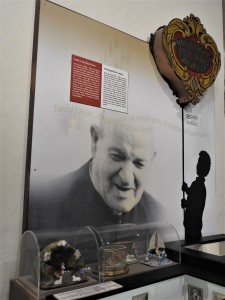 Although the main characters of the nativity scene are Joseph, Mary and baby Jesus, different cultures have added and altered the original representation in order to include their own characteristics. Some of these varying interpretations can be viewed in a permanent exhibition at the Inquisitor’s Palace in Birgu, which also houses the National Museum of Ethnography.
Although the main characters of the nativity scene are Joseph, Mary and baby Jesus, different cultures have added and altered the original representation in order to include their own characteristics. Some of these varying interpretations can be viewed in a permanent exhibition at the Inquisitor’s Palace in Birgu, which also houses the National Museum of Ethnography.In Malta, it was St George Preca (1880 – 1962) who fostered a lasting Christmas cult through his Society of Christian Doctrine. On Christmas Eve of 1921, he organized the first procession with a statue of baby Jesus. He also started the tradition of giving a crib and a statue of baby Jesus to every child who attended the MUSEUM centres.
In the exhibition, an image of Preca looks over at a rudimentary crib which has initiated a tradition that is still celebrated nowadays. A detailed diorama portrays further this tradition, showing a MUSEUM Superior handing out a crib to a boy, while a number of other children are already joyfully holding their cribs. An altar which is included in the diorama is decorated with flowing white vetch.
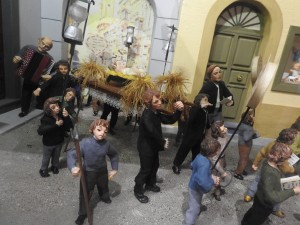 Another diorama looks like a time capsule showing the traditional procession of baby Jesus together with other local customs. Not only can one observe the MUSEUM members carrying the statue of baby Jesus, but one can also delight at the children carrying lights and Christmas messages while singing Christmas carols. The context is further enriched by the presence of traditional Maltese town houses, with their colourful wooden doors and with their wide open windows decorated with a small statue of baby Jesus.
Another diorama looks like a time capsule showing the traditional procession of baby Jesus together with other local customs. Not only can one observe the MUSEUM members carrying the statue of baby Jesus, but one can also delight at the children carrying lights and Christmas messages while singing Christmas carols. The context is further enriched by the presence of traditional Maltese town houses, with their colourful wooden doors and with their wide open windows decorated with a small statue of baby Jesus.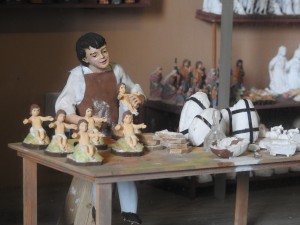 These two dioramas form part of a set that was donated to Heritage Malta by Austin Galea; a well-established artisan and personality among local crib enthusiasts, and a founding member of the Għaqda Ħbieb tal-Presepju (Malta). The set of dioramas give life to further Christmas traditions, such as the sermon of the altar boy during Christmas’ eve mass, a large crib displayed for public viewing, a group of craftsmen in a workshop manufacturing statues and cribs, and a Christmas lunch being enjoyed by a family.
These two dioramas form part of a set that was donated to Heritage Malta by Austin Galea; a well-established artisan and personality among local crib enthusiasts, and a founding member of the Għaqda Ħbieb tal-Presepju (Malta). The set of dioramas give life to further Christmas traditions, such as the sermon of the altar boy during Christmas’ eve mass, a large crib displayed for public viewing, a group of craftsmen in a workshop manufacturing statues and cribs, and a Christmas lunch being enjoyed by a family.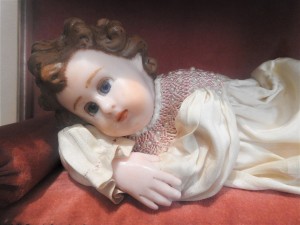 Galea has also donated two large nativity scenes which are typically exhibited in windows of private houses during the Christmas season in Malta. Other donations by him include different traditional statues of baby Jesus. Traditionally, the baby Jesus statues were made of wax to obtain a soft and translucent finish. The statues were eventually dressed up in an embroidered tunic, while many borrowed real hair from a toddler’s crowning curls.
Galea has also donated two large nativity scenes which are typically exhibited in windows of private houses during the Christmas season in Malta. Other donations by him include different traditional statues of baby Jesus. Traditionally, the baby Jesus statues were made of wax to obtain a soft and translucent finish. The statues were eventually dressed up in an embroidered tunic, while many borrowed real hair from a toddler’s crowning curls.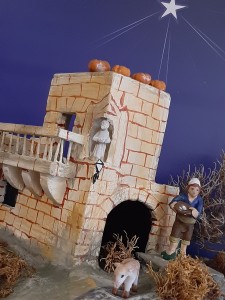 A large Maltese crib is also part of Galea’s generous donation. The crib is a comprehensive study of Maltese traditions in itself. Typical Maltese figurines are dressed in traditional local costumes, and among them, one also finds the unique Maltese symbolic characters. The Stupefied figurine represents those who are impressed by the profound meaning of the unique happening. The Beggar represents the poor who find consolation in Christ. The Climber represents those who find it difficult to understand the significance of Christ’s incarnation but strive to discover out. The Folk Singers represent communal association in praising the Lord, while the Sleeper represents those who ignore the immeasurable benevolence of Christ. The rugged landscape with its terraced fields, sparse vegetation, low-profile unpretentious farmhouses and a windmill are reminiscent of the rural ambience of the old times.
A large Maltese crib is also part of Galea’s generous donation. The crib is a comprehensive study of Maltese traditions in itself. Typical Maltese figurines are dressed in traditional local costumes, and among them, one also finds the unique Maltese symbolic characters. The Stupefied figurine represents those who are impressed by the profound meaning of the unique happening. The Beggar represents the poor who find consolation in Christ. The Climber represents those who find it difficult to understand the significance of Christ’s incarnation but strive to discover out. The Folk Singers represent communal association in praising the Lord, while the Sleeper represents those who ignore the immeasurable benevolence of Christ. The rugged landscape with its terraced fields, sparse vegetation, low-profile unpretentious farmhouses and a windmill are reminiscent of the rural ambience of the old times.Besides donating his first clay crib figurines which were given to him by his aunties and an unusual crib made of sacks that was constructed by him, Galea shares also his knowledge relating to Christmas crib construction in a short video which forms part of this exhibition.
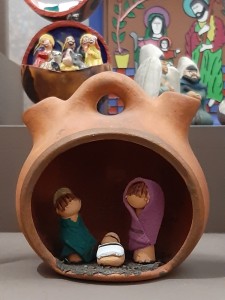 Another intriguing element in this exhibition is the donation of numerous miniature cribs which were brought by Albert and Lina McCarthy from all over the world. The professional tour managers have been gathering this impressive collection since the early 90s. Their collection amounts to more than 500 miniature works of art, a representative selection of which is on display at the Inquisitor’s Palace.
Another intriguing element in this exhibition is the donation of numerous miniature cribs which were brought by Albert and Lina McCarthy from all over the world. The professional tour managers have been gathering this impressive collection since the early 90s. Their collection amounts to more than 500 miniature works of art, a representative selection of which is on display at the Inquisitor’s Palace.Exhibited in four different sections, the varying nativity scenes representing North and East Europe, Southern Europe and the Near East, North and South America, and Africa, Asia, the Far East and Australia are simply enchanting. The magic is in the detail of each crib which presents the nativity scene in various contexts, with distinct characters and in diverse materials.
 Some of the most notable are the terracotta nativity sets from Hungary and Peru, the ceramic sets from Denmark and the Philippines, the engraved wooden shoe from Amsterdam, the wooden sets of Germany, Austria, Japan and Iran, the metallic artwork from Bali, the sack nativity set from Sri Lanka and the clay figurines of North Africa set in a bedouin tent, dressed in traditional costumes and accompanied by a camel instead of farm animals.
Some of the most notable are the terracotta nativity sets from Hungary and Peru, the ceramic sets from Denmark and the Philippines, the engraved wooden shoe from Amsterdam, the wooden sets of Germany, Austria, Japan and Iran, the metallic artwork from Bali, the sack nativity set from Sri Lanka and the clay figurines of North Africa set in a bedouin tent, dressed in traditional costumes and accompanied by a camel instead of farm animals.A visit to this permanent exhibition held at the Inquisitor’s Palace is most educational and entertaining for children, and also curious and insightful for adults. The exhibits are a tribute to local and foreign artisans who have used their creativity to reproduce the significant nativity scenes in various intriguing representations.
(Published in Christmas Times magazine issue with The Times of Malta dated 7th December 2019)
-
THE SISTERS OF THE CRIB
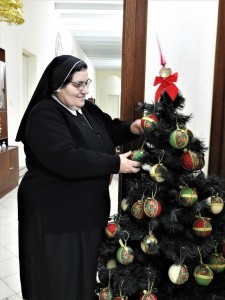 “This place was much livelier when children were around, especially in Christmas,” reminisced 60-year-old Madre Phyllis Agius of Jesus of Nazareth Institute in Żejtun. Around forty years ago, when she became a nun, the institute catered for orphans, teenage girls with family problems, and Muslim refugees. Nowadays, the nuns have dwindled to only nine and the institute serves mainly as a night shelter for the elderly.
“This place was much livelier when children were around, especially in Christmas,” reminisced 60-year-old Madre Phyllis Agius of Jesus of Nazareth Institute in Żejtun. Around forty years ago, when she became a nun, the institute catered for orphans, teenage girls with family problems, and Muslim refugees. Nowadays, the nuns have dwindled to only nine and the institute serves mainly as a night shelter for the elderly.“It was the need to take care of children which made me decide to become a nun. When I was a little girl, I noticed the institute’s orphans attending my same school in Żejtun and I hoped that one day, I would be able to give them all my love and support.”
She was initially approached by a nun while she was participating in a raffle which was being held at the institute as part of the Christmas activities.
“I visited the mechanical crib at this institute each year and like many others, I tried my luck at the raffle. On one of these days, I won the raffle but I had no idea which gift to choose. It was at that point that a nun gave me a pamphlet which read – Why not you? From then on, I began to consider becoming a nun.”
The large mechanical crib which was opened for the public in 1947, was one of the main attractions which brought people to the institute.
“People were simply amazed by this crib and its moving figurines. When it opened for the first time, crowds came from all over the island to see it. There were such long queues that people got restless waiting and the police had to be called in to calm the situation. By time, we became known as the sisters of the crib.”
 “No entrance fee was charged to visit this crib but people gave us donations to support the needs of our institute. Both this crib and also the orphans drew the attention of several benefactors who helped us to live a simple but comfortable life.”
“No entrance fee was charged to visit this crib but people gave us donations to support the needs of our institute. Both this crib and also the orphans drew the attention of several benefactors who helped us to live a simple but comfortable life.”Like Madre Phyllis, when I was young, I remember some of these young children who attended the primary school in Żejtun. They were always very smart and tidy.
“Older nuns recall a time when there were around two hundred children at this institute. There were not as many children when I became a nun, and the last group who lived here around twelve years ago, consisted of just six children. Although the children lived a disciplined life, they were all very dear to us, and some of them are still in contact with us.”
“Our children were always very busy during the Christmas season. Nuns trained them to participate in plays and also in the institute’s choir. A group of nuns who could play instruments organized a small orchestra which accompanied the choir. On Christmas eve, the Institute’s director would attend and he was always very pleased to see everyone having fun.”
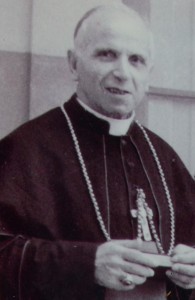 The first director of this institute and orphanage was none other than Bishop Emmanuel Galea, the very person who came up with the idea to construct the large mechanical crib.
The first director of this institute and orphanage was none other than Bishop Emmanuel Galea, the very person who came up with the idea to construct the large mechanical crib.“During the Christmas season, the children attended to many parties and they received several presents. Some of the children were also invited to spend the Christmas with families. It was such a happy time.”
“One of the nuns, Sister Ursola, was an excellent pastry maker. The aroma of baking Christmas cakes and qagħaq tal-għasel was heavenly during those days. Much of these sweets were given to our benefactors as a sign of gratitude.”
As no more children were left and fewer nuns joined the institute, life changed considerably. Now, most of the benfactors are gone and the elderly nuns have to rely on the help of friends and volunteers. Yet Christmas is still a cherished time.
“Three weeks before Christmas, we start with the Advent season which prepares us for the celebration of the Nativity of Jesus. This consists of teachings and readings during the daily mass that takes place at the institute’s church at 7.00am. Nine days before Christmas, we celebrate the novena which consists of readings and singing at the end of the mass.”
The expectation for Christmas triggers also a number of traditions within the institute.
“Volunteers come to help us to decorate the institute’s halls and rooms with cribs, baby Jesus statues, Christmas fathers and Christmas trees. One of the volunteers also takes care of growing vetch for us which is eventually used to decorate the institute’s church together with ponsiettas.”
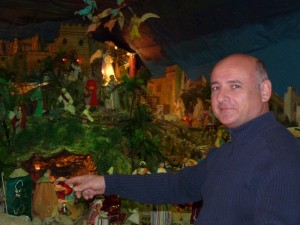 “Joseph Pavia, the nephew of Pawlu Pavia who constructed the mechanical crib, calls to check whether everything is fine with the crib and the figurines. In the meantime, we prepare the items for our Christmas bazaar from which we sell books, toys and crafts prepared by the nuns.”
“Joseph Pavia, the nephew of Pawlu Pavia who constructed the mechanical crib, calls to check whether everything is fine with the crib and the figurines. In the meantime, we prepare the items for our Christmas bazaar from which we sell books, toys and crafts prepared by the nuns.”The day before Christmas eve, Madre Phyllis prepares her renowned chocolate drink which has become a favourite with parishioners.
“My recipe consists of chunks of exquisite chocolate, drinking chocolate, baking chocolate, vanilla drops, sugar, and peel of oranges, lemons and mandarines. I melt and blend eveything together in two large cooking pots and leave the mixture to cook slowly.”
“This chocolate drink and a piece of Christmas cake are then offered to all those who attend to the Christmas eve mass which is celebrated at the institute’s church at 8.00pm. Children are also given a present by Father Christmas.”
The nuns spend Christmas day together at the institute.
“We wake up at 5.45am to say our prayers. Then we have breakfast and at 7.00am we attend to mass. Afterwards, we fill the nuns’ Christmas stockings with small presents which mainly consist of chocolates since they love them. Some of us receive family visits while others welcome the public at our crib. At noon we have lunch and we pray again.”
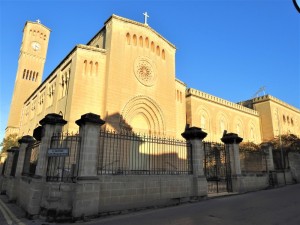 “After enjoying some rest, some of us stand again by the crib to receive the public. More people tend to come at this time, bringing along their families with them. Many people seek this annual opportunity to talk to us. It is pleasant to see that people still trust us and believe that we are a faster way to God,” she said as she smiled.
“After enjoying some rest, some of us stand again by the crib to receive the public. More people tend to come at this time, bringing along their families with them. Many people seek this annual opportunity to talk to us. It is pleasant to see that people still trust us and believe that we are a faster way to God,” she said as she smiled.Indeed, this is the time when people approach them to share their personal problems, seek advice, and ask for prayers. A good number of those attending give them donations to help with the needs of the institute.
“Christmas day ends with more prayers and dinner. Then we gather together to watch tv while enjoying some sweets and a sip of vermouth. After all Christmas is about being with family and this is our family now.”
The Institute of Jesus of Nazareth is located at St Gregory Street in Żejtun.
This year, the mechanical crib will be open between 16th December 2018 and 6th January 2019. Opening hours: 9.30am – noon and 4.00pm – 7.00pm all week.
(This feature was published in the Christmas Times issued with The Times of Malta on 8th December 2018)
-
AND THEY ALL CAME TO SEA
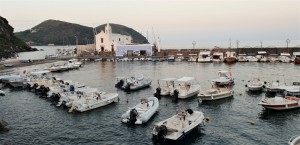 At the centre of the attractive small harbour of Marina Corta in Lipari, there is an unassuming quaint church dedicated to Our Lady of the Snow and to the Souls of Purgatory. One could easily fail to visit this place since fun and life beckons from the several restaurants, cafeterias and shops situated right across in the spacious square. Yet a most unique and pleasant surprise awaits those who decide to step inside.
At the centre of the attractive small harbour of Marina Corta in Lipari, there is an unassuming quaint church dedicated to Our Lady of the Snow and to the Souls of Purgatory. One could easily fail to visit this place since fun and life beckons from the several restaurants, cafeterias and shops situated right across in the spacious square. Yet a most unique and pleasant surprise awaits those who decide to step inside.The church was built in 1545, just five years after the island of Lipari was sacked by the Turkish corsair Barbarossa who took away almost the entire population into slavery. Defiantly constructed on the jutting rocks, the church intended to serve as a point of reference for those who repopulated the island.
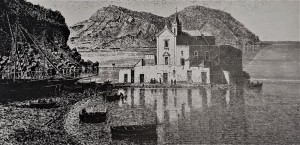 However, along the years, as other chapels and churches were built around Lipari, this church was abandoned and left to its own destiny. Critically close to the sea, the building suffered severe damage, and in recent years, it was on the brink of collapse.
However, along the years, as other chapels and churches were built around Lipari, this church was abandoned and left to its own destiny. Critically close to the sea, the building suffered severe damage, and in recent years, it was on the brink of collapse.On a cold winter day in 2011, with the rough seas hitting mercilessly at this church, a group of locals decided to save this place. They were all saddened by the neglected state of this historical building and they were adamant to do something about it. After they came out with a plan, they discussed their ideas with their parish priest, Fr Giuseppe Mirabito, who agreed at once to collaborate with them.
The Association SS. Cosma and Damiano Marinacorta was established to coordinate this project. The stability of the building was the first thing which had to be addressed quickly. As the members of the association talked about this project with other locals and friends, support came in the form of the required materials and voluntary help. In time, the external part of the church was restored. However, the internal area of the church remained in dire need of restoration.
 As the building started to regain its dignity, the association’s members needed to come up with new ideas to attract visitors to the church. Their main aim was to create more awareness about the historical and cultural value of this building so that more people would help out with this venture, particularly with the funds which were required to restore the church completely.
As the building started to regain its dignity, the association’s members needed to come up with new ideas to attract visitors to the church. Their main aim was to create more awareness about the historical and cultural value of this building so that more people would help out with this venture, particularly with the funds which were required to restore the church completely.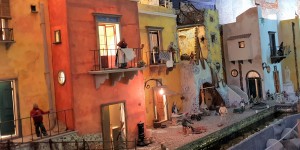 Since it was close to Christmas, they decided to build a crib inside the church. But this was no ordinary crib with religious iconography. Instead, it was laid out to represent the fishing village of Lipari as it was in the old days and it was named Presepe del Mare.
Since it was close to Christmas, they decided to build a crib inside the church. But this was no ordinary crib with religious iconography. Instead, it was laid out to represent the fishing village of Lipari as it was in the old days and it was named Presepe del Mare.Peppuccio Costanzo, one of the association’s members and a fisherman, assisted in the design of this crib which was made of papier-mache. The miniature village was a replica of the real buildings, architecture and life that existed in Lipari around fifty years ago. A number of known village characters were also included in this most unusual crib.
 The crib’s landscape was built along a watercourse with real fish living inside. The crib is mostly populated by fishermen, some of whom are at work while others are idling around. The attention which was given to the details in this crib acts as a time capsule to help visitors visualize better how Lipari looked before it was regenerated to suit the needs of the increasing tourist demands. It also pictures several traditions of the time. Locals may even recognize some of the people represented in the figurines; a number of whom have by now passed away.
The crib’s landscape was built along a watercourse with real fish living inside. The crib is mostly populated by fishermen, some of whom are at work while others are idling around. The attention which was given to the details in this crib acts as a time capsule to help visitors visualize better how Lipari looked before it was regenerated to suit the needs of the increasing tourist demands. It also pictures several traditions of the time. Locals may even recognize some of the people represented in the figurines; a number of whom have by now passed away.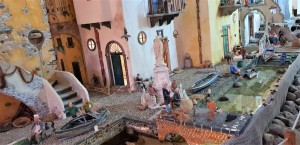 Existing landmarks such as the church of St Joseph and the statue of St Bartholomew serve as identifying marks in the changing village. Gone are most of the old houses which can be seen in the crib. Today, these have been replaced by higher modern buildings. Traditional life as shown in the crib has almost dissolved into nothingness. Tradesmen’s shops have been taken over by modern outlets selling souvenirs or boat rides. The fish seller who called out in the streets, nowadays displays his fish in a van. Women do not carry water jugs anymore; tap water is now readily available. Clothes are no longer washed in public places; washing machines take care of this matter. The young man who played the guitar beneath the balcony of the girl he loved will today send her an sms instead.
Existing landmarks such as the church of St Joseph and the statue of St Bartholomew serve as identifying marks in the changing village. Gone are most of the old houses which can be seen in the crib. Today, these have been replaced by higher modern buildings. Traditional life as shown in the crib has almost dissolved into nothingness. Tradesmen’s shops have been taken over by modern outlets selling souvenirs or boat rides. The fish seller who called out in the streets, nowadays displays his fish in a van. Women do not carry water jugs anymore; tap water is now readily available. Clothes are no longer washed in public places; washing machines take care of this matter. The young man who played the guitar beneath the balcony of the girl he loved will today send her an sms instead. The crib’s culmination and originality is certainly in the warm and simple nativity scene where fishermen are greeting baby Jesus, not sheperds. Colourful fishing boats and straw fishermen’s baskets are present in the area, not hills and sheep. An angel sings besides a balcony of a house not on top of a cave.
The crib’s culmination and originality is certainly in the warm and simple nativity scene where fishermen are greeting baby Jesus, not sheperds. Colourful fishing boats and straw fishermen’s baskets are present in the area, not hills and sheep. An angel sings besides a balcony of a house not on top of a cave.As people came to visit this crib, it became evident that this was more than a seasonal project. Soon it was decided that this crib should remain in this church as a cultural symbol of Lipari. The crib would be visitable all around the year and whoever paid the entrance fee of €1 would be assisting in the restoration of the church.
 By now, Presepe del Mare has come to form part of the cultural identity of Lipari. Besides presenting the craftsmanship of those who made it, the crib is also a relevant reminder of the importance of keeping traditions alive and of conserving the remaining architecture of the area.
By now, Presepe del Mare has come to form part of the cultural identity of Lipari. Besides presenting the craftsmanship of those who made it, the crib is also a relevant reminder of the importance of keeping traditions alive and of conserving the remaining architecture of the area.Info about Lipari: The island of Lipari is the largest of the Aeolian volcanic archipelago. Nowadays, its population is around 12,700, although it generally reaches 20,000 during the tourist season, from May to September. Due to its charming character, historical value and holiday atmosphere, Lipari is a top destination. Fast ferry connections from Sicily all stop at this island, as well as plenty of boats and hydrofoils, making it the ideal place to reach the other islands in the archipelago – Vulcano, Salina, Stromboli, Filicudi, Alicudi, Panarea and Basiluzzo.
(This feature was published in The Christmas Supplement issued with The Sunday Times of Malta on 2nd December 2018)
-
LIGHTS OUT FOR CHRISTMAS
Christmas time and the days preceding it are generally associated with colour, light, optimism and fun. Yet this was not the case in 1939 when the Christmas season became synonymous with gloom, darkness, uncertainty and fear.
On 18 September 1939, a table showing the duration of the ‘Official Night’ was published in Government Notice No. 459 in The Malta Government Gazette. This table included each day of each month and the beginning and end of what was to be considered as the official night hours. Such instructions formed part of the Malta Defence Regulations, 1939, which aimed to protect the Maltese Islands and its inhabitants as World War II ravaged in other countries.
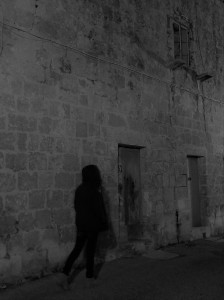 Two days later, on 20 September 1939, Government Notice No. 473 issued the Lights Restriction Order which was effective from that day. The directions of this Order had to be observed between midnight and 4:30am on every day of the week, and also between 10:00pm and midnight on Fridays. During these times, all lights in any building had to be masked to be invisible from the sea and from the air. No lights, other than lights authorised by the competent authority, were permitted in any open spaces whether private or public, in yards, roofs or open verandas. The use of illuminated lettering or signs in any shops were prohibited unless authorised by the Commissioner of Police or the competent authority. The traffic of motor vehicles during these hours was banned and any vehicles which did not comply with these provisions could be stopped and detained until 6:00am. Obviously, all fireworks were also prohibited.
Two days later, on 20 September 1939, Government Notice No. 473 issued the Lights Restriction Order which was effective from that day. The directions of this Order had to be observed between midnight and 4:30am on every day of the week, and also between 10:00pm and midnight on Fridays. During these times, all lights in any building had to be masked to be invisible from the sea and from the air. No lights, other than lights authorised by the competent authority, were permitted in any open spaces whether private or public, in yards, roofs or open verandas. The use of illuminated lettering or signs in any shops were prohibited unless authorised by the Commissioner of Police or the competent authority. The traffic of motor vehicles during these hours was banned and any vehicles which did not comply with these provisions could be stopped and detained until 6:00am. Obviously, all fireworks were also prohibited.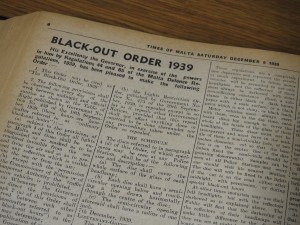 An Air-Raid Precautions Order was communicated in Government Notice No. 504 on 4 October 1939. Eventually on 9 December 1939, The Times of Malta published the provisions of The Black-Out Order, 1939, which had to be observed on every day of the week between midnight and the official sunrise. During these hours, all the lights on the Islands had to be extinguished or masked as to be rendered invisible from the sea and from the air. Special Black-Out hours could also be determined when necessary.
An Air-Raid Precautions Order was communicated in Government Notice No. 504 on 4 October 1939. Eventually on 9 December 1939, The Times of Malta published the provisions of The Black-Out Order, 1939, which had to be observed on every day of the week between midnight and the official sunrise. During these hours, all the lights on the Islands had to be extinguished or masked as to be rendered invisible from the sea and from the air. Special Black-Out hours could also be determined when necessary. As part of the Black-Out Order, from 14 December 1939, all motor vehicles which had to travel at night, other than those belonging to His Majesty’s service, had to have their bulbs removed from their lamps. Opaque cardboard discs were to be fixed to the lights of the vehicles and the reflectors’ surface had to be covered with a non-reflecting substance. A white disc had to be affixed at the back of all motor vehicles at a height of three feet from the ground to make them visible on the roads. Traffic of motor vehicles during the black-out was prohibited except for those who obtained permission from the Commissioner of Police or a competent authority.
Another notice which appeared on The Times of Malta of the 9 December 1939 urged the inhabitants to comply with these regulations for their own safety. People were recommended to stay at home and to avoid going out in the darkness. Those who needed to get out were advised to walk on the right-hand side of the road to face oncoming traffic and to carry with them a white object to make them more visible to drivers. Owners of goats were informed to keep their animals off the road at night. On the other hand, drivers were cautioned to drive very slowly and with great care.
Measures were being taken to prepare the people how to take the necessary precautions in preparation of an expected war. Black-outs intended to prevent crews of enemy aircraft from being able to identify their targets by sight. Nonetheless, these precautionary provisions proved to be one of the more unpleasant aspects of war, disrupting many civilian activities and causing widespread grumbling and lower morale.
The Times of Malta of 13 December 1939 reports that some misapprehension had arisen among that section of the public who had to rise early for work and travel by early buses, since it was not clear at what time the bus service started. Indeed, all buses were to continue their usual service provided that they adhered to the regulations regarding headlights and lights, including the inside of the vehicles which had to remain in darkness.
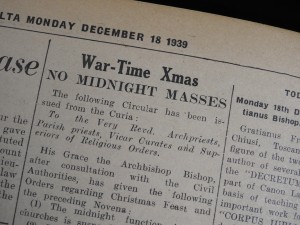 Even though the Maltese Islands were not yet directly involved in war, a foreboding atmosphere crept its way into the lives of people. As if matters were not yet miserable enough, a Bishop’s Circular which was published on The Times of Malta of 17 December 1939 declared that the Christmas midnight function in the churches was to be suspended. The Novena and feast functions could be celebrated from 4:00am onwards provided that no lights were visible from the outside. Those churches which required singers and musicians from far places for the early Christmas function had to apply to the Commissioner of Police for the necessary permits to travel. While it was permissible to give a small sign to the faithful by the ringing of bells for the function of the Novena and Christmas Eve, this had to be done according to predetermined rules.
Even though the Maltese Islands were not yet directly involved in war, a foreboding atmosphere crept its way into the lives of people. As if matters were not yet miserable enough, a Bishop’s Circular which was published on The Times of Malta of 17 December 1939 declared that the Christmas midnight function in the churches was to be suspended. The Novena and feast functions could be celebrated from 4:00am onwards provided that no lights were visible from the outside. Those churches which required singers and musicians from far places for the early Christmas function had to apply to the Commissioner of Police for the necessary permits to travel. While it was permissible to give a small sign to the faithful by the ringing of bells for the function of the Novena and Christmas Eve, this had to be done according to predetermined rules.Albeit the continuous warnings and pleas to adhere strictly to the black-out orders, it seemed that not everyone was following the rules. An announcement on The Times of Malta of the 20 December 1939 issued by the Lieutenant’s Government Office advised the public that the black-out on the night of December 15-16 was not entirely satisfactory, and that there were several lights showing in the Valletta, Sliema, Hamrun, Cospicua and Naxxar districts. Several lights were only put out as aircraft passed overhead. This notice pointed out also that a section of the public could still have been unaware of the black-out rules since they seemed to have been published only on The Times of Malta and Il-Berqa newspapers. Illiterate persons would therefore have had no way of being forewarned except by hearsay. Therefore, a siren warning which was different from the Air-Raid alarm signal, was recommended to be given throughout the islands at sunset.
Letters by readers in the Correspondence section of The Times of Malta of the 20 and 21 December 1939 vent their frustration and contempt at those who were not taking these black-out precautions seriously:
“Many people rather irresponsibly remark that they do not quite see the use of strict black-outs when Germany is at such a distance away. The reply is that precaution is better than cure. I am sure that these people will think very different if they find one day a German bomb dropping at their door-step or in their backyard, just because some stray lights guided an enemy to an objective.” Signed ‘Common-Sense’.
“I am sure that a number of law-abiding citizens in these islands feel that the time has come for coercion to replace coaxing. Those people who scorn to comply with reasonable regulations are either knaves or fools and most dangerous to the community in war time; they should be under lock and key for the duration of the war: either in jail or in a lunatic asylum. The pathetic appeals made by the authorities are becoming nauseating.” Signed Lieutenant Colonel (retired) H. M Marshall.
 Special Black-Out arrangements for Christmas and New Year, published on The Times of Malta of the 23 and 30 December 1939, informed the public that the black-out of buildings on the nights of 24 – 27 December and 30 December – 1 January were to be postponed for one and a half hours from midnight. On these nights, motor vehicles were allowed on the road without requiring special permission until 1:30am, and shops and places of entertainment could remain open until 1:00am.
Special Black-Out arrangements for Christmas and New Year, published on The Times of Malta of the 23 and 30 December 1939, informed the public that the black-out of buildings on the nights of 24 – 27 December and 30 December – 1 January were to be postponed for one and a half hours from midnight. On these nights, motor vehicles were allowed on the road without requiring special permission until 1:30am, and shops and places of entertainment could remain open until 1:00am.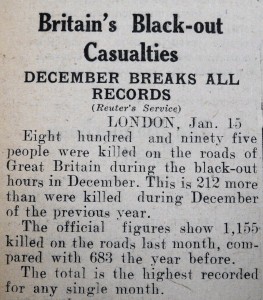 Possibly few had considered that light could be their enemy until it became essential to extinguish it. There was no mention of accidents or fatalities due to the black-out on the Islands in the December’s Times of Malta newspapers. However, reports from Great Britain relating to the high increase in road fatalities during the night were quite shocking. On 13 December 1939, the British Official Press stated that road fatalities had increased considerably from September to November. Yet the worst scenario took place in December, as reported by the Reuter’s Service on 16 January 1940, when 895 people were killed on the roads of Great Britain during the black-out hours. This was 212 more than those who were killed during December of the previous year.
Possibly few had considered that light could be their enemy until it became essential to extinguish it. There was no mention of accidents or fatalities due to the black-out on the Islands in the December’s Times of Malta newspapers. However, reports from Great Britain relating to the high increase in road fatalities during the night were quite shocking. On 13 December 1939, the British Official Press stated that road fatalities had increased considerably from September to November. Yet the worst scenario took place in December, as reported by the Reuter’s Service on 16 January 1940, when 895 people were killed on the roads of Great Britain during the black-out hours. This was 212 more than those who were killed during December of the previous year.This was surely a strange Christmas to the Maltese people who are accustomed to celebrate these days in a profuse way. Although through no fault of their own, they were involved in war and they had to adapt to war conditions. Alas, much worse was yet to come.
(This article was published in the Christmas Times magazine issued with The Times of Malta dated 13 December 2017)
-
Long shell life
 Although during the Christmas season, it is customary to see statues of baby Jesus in a manger or in a crib, in Candice Fava’s shop New EGGsperience, the holy child would be seen resting in a decorated eggshell.
Although during the Christmas season, it is customary to see statues of baby Jesus in a manger or in a crib, in Candice Fava’s shop New EGGsperience, the holy child would be seen resting in a decorated eggshell.“I love to create unique hand-made objects and this craft of eggshell decoration has provided me with the opportunity to have my own niche market,” Fava explains.
Fava was raised on a farm in Australia, where her family sold eggs. They had several clients but one particular client intrigued Fava since she regularly purchased a substantial quantity of eggs.
“One day I decided to ask her why she always needed so many eggs and she promised that the next time she called at our farm, she would bring me a gift to show me. I felt deeply curious and I awaited her next visit with much anticipation. Eventually, she brought me a little jewel box adorned with lovely fabrics and accessories. I could not believe that she had actually made it with one of the eggs from our farm!”
 Fava was so fascinated with this idea that she decided to learn this craft. At the farm, she had all the eggs that she required and in time she learnt how to clean them without breaking them. Soon, she was producing her own eggshell decorations.
Fava was so fascinated with this idea that she decided to learn this craft. At the farm, she had all the eggs that she required and in time she learnt how to clean them without breaking them. Soon, she was producing her own eggshell decorations.“The first item I made was a jewel box which I painted with bright nail polish. I was so delighted when I saw it ready! Today I realize that it wasn’t much but it is still very dear to me as it reminds me from where it all started.”
Along the years, eggshell decoration became an integral part of Fava’s life. Which explains why she was surprised when she came over to Malta and realized that this craft was totally unknown on the island.
“It was hard at first to find the necessary materials to work with. However, my husband Ivan helped me to locate some local farms which could provide me with eggs. He also assisted me in the cleaning and sterilization of the eggshells.”
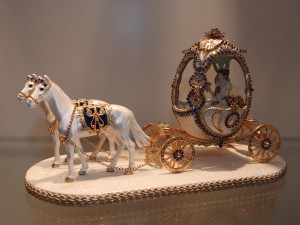 Initially she decorated eggshells for her personal enjoyment. Then she began to give them out as gifts to her friends.
Initially she decorated eggshells for her personal enjoyment. Then she began to give them out as gifts to her friends.“My friends were delighted with these eggshell decorations since they had never seen anything like them before. Soon they were asking me to make some more creations for them so that they could give them as presents to others. It was only a matter of time until I confirmed that there was a demand for such products.”
Ultimately, people’s positive reactions to her craft led her to open her own shop in Zabbar.
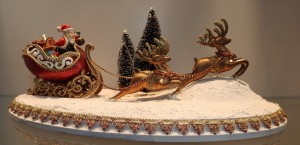 “By then, I had produced so many various eggshell decorations that I had no difficulty to fill the shop with my creations. Each time that new clients come in, it is charming to see their incredulity that so many exquisite things can be made from common fragile eggshells.”
“By then, I had produced so many various eggshell decorations that I had no difficulty to fill the shop with my creations. Each time that new clients come in, it is charming to see their incredulity that so many exquisite things can be made from common fragile eggshells.”Nowadays, the Favas have located foreign suppliers who are able to furnish them with quantities of ready-made cleaned and sterilized eggshells. Moreover, they have also managed to establish contacts with suppliers of other materials with which the eggshells are decorated.
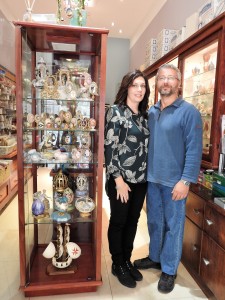 “My husband supports me a lot and helps me to come out with new ideas. Along the years, he too became enthusiastic about this work and now he is able to make his own creations.”
“My husband supports me a lot and helps me to come out with new ideas. Along the years, he too became enthusiastic about this work and now he is able to make his own creations.”A wide range of differently decorated eggshells which are ideal as gifts for various occasions are displayed at their shop. However, a few of them are not for sale.
“When we join forces, we create the best decorations,” the two agree. “The collaboration of ideas lead to exclusive objects which become difficult to part from. Some of them, such as the lamp shade, the handbag set and the sea vessel, are cherished objects and we have won prestigious awards for them at local national craft competitions. Such works provide us also with the opportunity to combine different materials and crafts like woodwork and eggshell decoration. Our imagination has no limit, however we are restrained with the eggshells’ curvatures, although we take that as part of the challenge.”
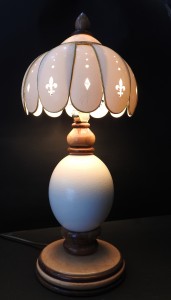 Even though all of the creations may serve as decorations, some of them also have their own practical use, acting as exotic containers, wearable accessories or light fittings.
Even though all of the creations may serve as decorations, some of them also have their own practical use, acting as exotic containers, wearable accessories or light fittings.“Besides selling our creations from my shop, I also participate in several fairs and exhibitions and therefore more people are getting to know about this craft. Presently I am also taking part in the program Niskata which airs on TVM. Yet there is still much more to do to create more awareness.”
“It is great to see how far a simple hobby can take you. Little by little, all my family has become involved in this craft. In fact, my daughter is already coming up with her own designs and creations and my little son is showing interest too.”
In these last years, Fava has also dedicated herself to teach this craft to all those who are interested, both children and adults. She has also furnished her shop with all the necessary materials including eggshells of various sizes, cut eggshells, acrylic paints, stands, bases and a multitude of other items.
As Christmas time approaches, the two explore the possibility of new designs and ideas in order to come out with original creations which relate to this theme.
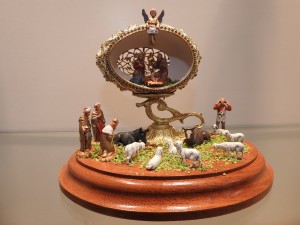 “We are always dreaming of what we are going to do next. We work with all sorts of eggshells, starting with the smallest ones of love-birds and parrots, and moving on to larger ones such as those of pigeons, quails, ducks, geese, emu, rhea and ostrich. The geese’s eggs are the most practical because of their size and shape. Other eggs are relished for their natural particular characteristics such as the blackish colour of the rhea eggs and the large shape and pearly shade of the ostrich eggs.”
“We are always dreaming of what we are going to do next. We work with all sorts of eggshells, starting with the smallest ones of love-birds and parrots, and moving on to larger ones such as those of pigeons, quails, ducks, geese, emu, rhea and ostrich. The geese’s eggs are the most practical because of their size and shape. Other eggs are relished for their natural particular characteristics such as the blackish colour of the rhea eggs and the large shape and pearly shade of the ostrich eggs.”“Christmas brings a lot of joy and memories. This festive season opens up a whole new world to create related items with baby Jesus statues, cribs, angels, Father Christmas, reindeers, sparkles and a whole range of bright colours. We love to reflect the warm meaning of Christmas in our works.”
-
Christmas inspiration
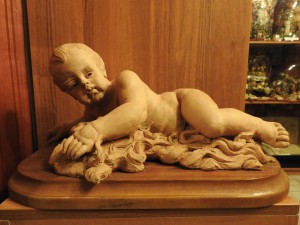 Thousands of baby Jesus statues begged for my attention during a visit at Il-Mużew tal-Bambini in Birkirkara. However, I felt mostly intrigued by a particular terracotta figure which looked completely different from the rest. Its face had captivatingly unique features and the rest of the body was very life like. Yet it was only when I met its creator, sculptor Chris Ebejer, that I understood its real value, since that baby Jesus was not just a statue but a singular work of art.
Thousands of baby Jesus statues begged for my attention during a visit at Il-Mużew tal-Bambini in Birkirkara. However, I felt mostly intrigued by a particular terracotta figure which looked completely different from the rest. Its face had captivatingly unique features and the rest of the body was very life like. Yet it was only when I met its creator, sculptor Chris Ebejer, that I understood its real value, since that baby Jesus was not just a statue but a singular work of art.“My baby Jesus creations are not popular statues that are meant for domestic use or simply to act as a representation of the son of God. They have an added value because they are sculptures and not just statues,” explained Chris when I met him at his studio in Mqabba.
“When I do such works, my aim is not only to reproduce the tenderness of a baby but also to relay an artistic style and a distinct message. Such art pieces are not restricted just to the Christmas season but they can be cherished all throughout the year due to their artistic significance.”
An unfinished terracotta sculpture of a toddler Jesus lay waiting on a workbench. I couldn’t help noticing some subtle facial similarities between this work and the other one that I had viewed before. I was curious to know whether a sculptor would have a specific image in mind of how Jesus should be represented.
“Before starting to work on something, an artist needs to have a vision of what he intends to create. One wouldn’t picture the exact image in mind but there would already be an idea of the shape, the composition, and the layout of the figure. Details will not be clear but each artist will subconsciously compose some particular features which are typical of his style.”
“I must say that the facial features of this figure were inspired by those of my nephew. When he was a baby and later on a toddler, I studied closely his facial characteristics in order to explore the difference that exists between such a young face and that of an adult. For example, I observed that a toddler’s forehead is large when compared to the rest of the face, the upper lip is usually protruding, the cheeks are chubby and the neck is fleshy.”
The sculpted figure of Jesus looked quite human and earthly and I wondered whether such work involved a spiritual process as well?
“Whenever I am creating a sculpture, my foremost thought is always art. I am not motivated by any religious intentions and I do not aspire to encourage faith or to have people praying in front of my work. I have to admit that the subject is irrelevant to me.”
Nonetheless, although creativity and originality are always his primary goals, Chris revealed that there is a limit on how much one can move out of the religious figures’ codified facial characteristics which our culture has learnt to decipher and expect.
“No one has any idea how Jesus actually looked like, neither as a baby or a child, nor as an adult. Indeed, both his face and the way in which he is represented have changed considerably along the centuries. The belief that some images such as the Veil of the Veronica and the Shroud of Turin could be historically authentic has influenced very much the present impression of Jesus’s face. Once such images are portrayed over and over again and are accepted by society, their characteristics become codified and this will help people to recognize immediately the figure of Jesus. Certainly, as an artist, there are ways and means of how to be creative when dealing with such a significant figure. However, one must know his limits so as not to come out with a profane work.”
In earlier times, when art could reach out to people more than books, especially due to widespread illiteracy, the Catholic Church often used symbols within artistic works to deliver its messages.
“There were various symbols that were portrayed with baby Jesus. In Botticelli’s artwork Madonna of the Pomegranate, Jesus is holding a pomegranate in representation of his suffering and resurrection. On the other hand, in the Madonna of the Carnation by Leonardo da Vinci, Jesus is reaching out to a carnation which is the symbol of Passion.”
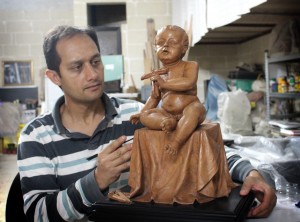 Chris pointed out to his sculpture of toddler Jesus where he had also included such symbols.
Chris pointed out to his sculpture of toddler Jesus where he had also included such symbols.“Although in this sculpture, Jesus might look just like any child, there are a number of clues which will hint to the viewer that there is more to it than that. In fact, the child in sitting on a humble box draped in cloth in allusion to when the babies of ancient royal families were placed on thrones. The young figure is holding a miniature cross in his hand and three nails lie down beneath him on the ground. All these objects, together with the boy’s meditative expression as he looks far out beyond his tender age, create an effect which suggests that the child is already seeing his mission for the future.”
As he continues with some final touches on this latest sculpture, Chris reveals that the autumn and wintery seasons tend to inspire him to create new works.
“I am deeply influenced by the change of seasons and by the transformation which they breed in the coloured landscape. Being from the rural village of Qrendi, I am very attracted to nature and my senses are intensely attuned to it. As the leaves start turning orangey red, melting in with the aroma of wet brown soil and the liquorish scent of carobs, I feel stimulated to think about Christmas and the birth and life of Jesus, and it is mainly during this period when I come up with new ideas for works with religious themes. Moreover, the earlier approach of night during these days entices me to stay more indoors and this provides me with much more time to work.”
A look at some of his finished works that were in his studio indicated that this sculptor had a particular preference to terracotta.
“I do love working with terracotta as besides being a natural medium, it also has a pleasant warm colour. It is also more fluid and softer to handle than other materials and so it allows me to work in greater tranquillity. The fact that terracotta has been in use since ancient times enhances also in me that sublime feeling that by utilising this medium, I am helping to keep this traditional technique alive.”
Apart from baby Jesus sculptures, during this season, Chris tends also to come out with new nativity creations.
“Tenderness and the love for the family are the main messages imbued in these works.”
(This article was published in Christmas Times magazine issued with The Times of Malta dated 8th December 2016)
-
A Christmas Nursery
Even as a young child, Paul Pace was very fond of baby Jesus statues. Probably because they reminded him of a number of significant familial moments. His grandma gave him a small wax statue of baby Jesus in order to ease down his sorrow after his father George had to leave for a long time to work with the Navy. On another occasion, his father surprised him when he bought him an expensive statue of baby Jesus that he had longed for, after he succeeded to win a lottery. Now, at 69, Paul owns a collection of more than 2000 of such statues which he has lovingly gathered in a museum that he called ‘Il-Mużew tal-Bambini’.
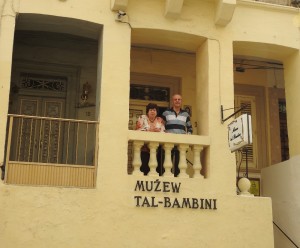 His wife Mary shares his passion and she is always present to give him a hand in this museum which they have purchased together.
His wife Mary shares his passion and she is always present to give him a hand in this museum which they have purchased together.“It is such a pleasure to see people getting emotional when they visit our museum. Some become very nostalgic as they remember their childhood. Others notice some statue which was similar to the one that their parents had, and they start recalling their memories. A number of visitors get inspired to buy a baby Jesus statue of their own, while some others decide to go home and search for their neglected antique statue which their grandma had left them,” Paul said.
Since its inauguration in 2010, il-Mużew tal-Bambini has become quite renowned both with the local and the foreign public. Although it is available for viewing by appointment throughout the year, most of the visitors attend to this museum during the Christmas season.
“There is always something new to see because we are continually adding to our collection. Even though by now, we have a problem with space, when we find a particular baby Jesus statue which we love, we just can’t help not to own it,” admitted Mary.
Certainly, the museum is a wonder to behold. The provenance of the statues is worldwide, thereby providing a rich overview of the different cultures. Skin colour, facial characteristics, and posture of these statues vary accordingly.
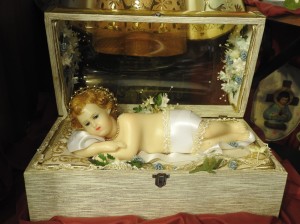 A delicate looking baby Jesus which was made in Malta, rests in a musical box and moves his eyes and hands. A dark skinned baby Jesus made from wood in Tanzania looks exotic amongst the others. A curly black-haired toddler Jesus, wearing the traditional costume of Perù, sits on a chair and weeps after stepping on a thorn, according to a local legend. A wooden statue from Betlehem shows Jesus as a boy dressed as a king and sitting on an elegant throne. A teenage Jesus from Atocia is also resting on a chair, but this time, he wears the clothes of a pilgrim and carries a rod. An intricately adorned statue of Jesus from Trapani is embellished with pomegranate for good luck.
A delicate looking baby Jesus which was made in Malta, rests in a musical box and moves his eyes and hands. A dark skinned baby Jesus made from wood in Tanzania looks exotic amongst the others. A curly black-haired toddler Jesus, wearing the traditional costume of Perù, sits on a chair and weeps after stepping on a thorn, according to a local legend. A wooden statue from Betlehem shows Jesus as a boy dressed as a king and sitting on an elegant throne. A teenage Jesus from Atocia is also resting on a chair, but this time, he wears the clothes of a pilgrim and carries a rod. An intricately adorned statue of Jesus from Trapani is embellished with pomegranate for good luck.“Our interest in this aspect has led us to travel to countries which are related to the life of Jesus, and from which we knew that we could find such statues. Our visit to the Holy Land was an incredible experience which gave us the opportunity to walk in the same roads where Jesus lived. Moreover, it was an ideal country from where to acquire some beautiful statues for our collection,” remarked Paul.
“When we visited Prague, we bought 42 different baby Jesus statues!” exclaimed Mary.
 They just had to, they explained, as they saw my startled reaction. This was because according to an old tradition, the statue of baby Jesus in Prague is dressed in different coloured clothes each day. Therefore, they were bound to purchase a number of statues which showed Jesus in several dresses. Nevertheless, not all the statues bought ended up in the museum, since some of these were presents for family members and friends.
They just had to, they explained, as they saw my startled reaction. This was because according to an old tradition, the statue of baby Jesus in Prague is dressed in different coloured clothes each day. Therefore, they were bound to purchase a number of statues which showed Jesus in several dresses. Nevertheless, not all the statues bought ended up in the museum, since some of these were presents for family members and friends.“Many of those who visit our museum are curious to know whether we can remember all our statues, which of course, we do. We can also recall all the places from where we have obtained these items. Each statue has an interesting story behind it and we love to share them with whoever’s interested to listen,” Paul said.
I was all ears and I felt simply fascinated when their narrative started to pour in. One of these stories entailed how they managed to buy a statue of baby Jesus which belonged to St. Ġorġ Preca. Another was related to an excellent bargain which Mary made unknowingly, when she bought a statue for her husband for a low price, and then found out that it dated to the 18th century. I loved also the account relating to a particular container made of mica which was produced in Malta by a German prisoner of war during World War II, and was utilized to hold a statue of baby Jesus.
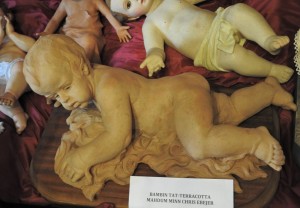 “We have many antique statues but the oldest one that we know the date of goes back to 1730. The smallest statue is about 15mm long, whereas the largest one has a length of 80cms. The materials of these statues varies widely and include: stone, alabaster, marble, woods of different kinds, wax, ceramic, concrete, lava, straw, plastic, wool, and even bull’s horn,” Mary explained.
“We have many antique statues but the oldest one that we know the date of goes back to 1730. The smallest statue is about 15mm long, whereas the largest one has a length of 80cms. The materials of these statues varies widely and include: stone, alabaster, marble, woods of different kinds, wax, ceramic, concrete, lava, straw, plastic, wool, and even bull’s horn,” Mary explained.Yet the strangest was yet to come…
“One day, we had a statue which lost its synthetic hair and we decided to try to replace it with some hair of one of our daughters. The experiment succeeded and soon, we provided the hair to a number of other statues by trimming some hair from our other daughter and eventually also from that of our nephews,” smiled Paul as he pointed them out proudly.
Each time that I observed the statues, I noticed a different one which I had not seen before. The collection looked literally endless, and yet each statue was unique. Whilst some of the statues showed simple features, mostly due to the artistic fashion of the time, others were quite elaborate and pretty. Yet there were also a number of outstanding characters which stood out from the rest.
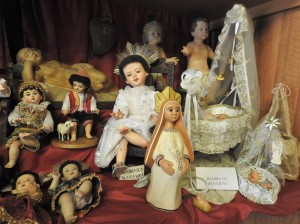 “The main aim of this museum is to share the sweetness of Christmas and the joy which is inherent in each statue of baby Jesus,” revealed the couple.
“The main aim of this museum is to share the sweetness of Christmas and the joy which is inherent in each statue of baby Jesus,” revealed the couple.However, this place offers much more than that since it nurtures love for one’s family, whilst it cherishes an appreciation for diversity. Undoubtedly, this collection is also an invaluable source for those who are interested to study the changes which took place along the years in the production of such precious artworks.
Il-Mużew tal-Bambini which is located at 17, Triq Santa Tereża, Birkirkara, will be open for the public from Sunday, 13th December 2015 to Wednesday, 6th January 2016.
Opening times: Monday to Saturday from 4:30pm – 8:00pm, Sundays and Public Holidays from 9:00am – noon and from 4:30pm – 8:00pm. For more information, one can call 21492111.
(This article was published in CHRISTMAS TIMES Suppliment issued with The Times of Malta dated 8th December 2015)
-
A Traditional Crib
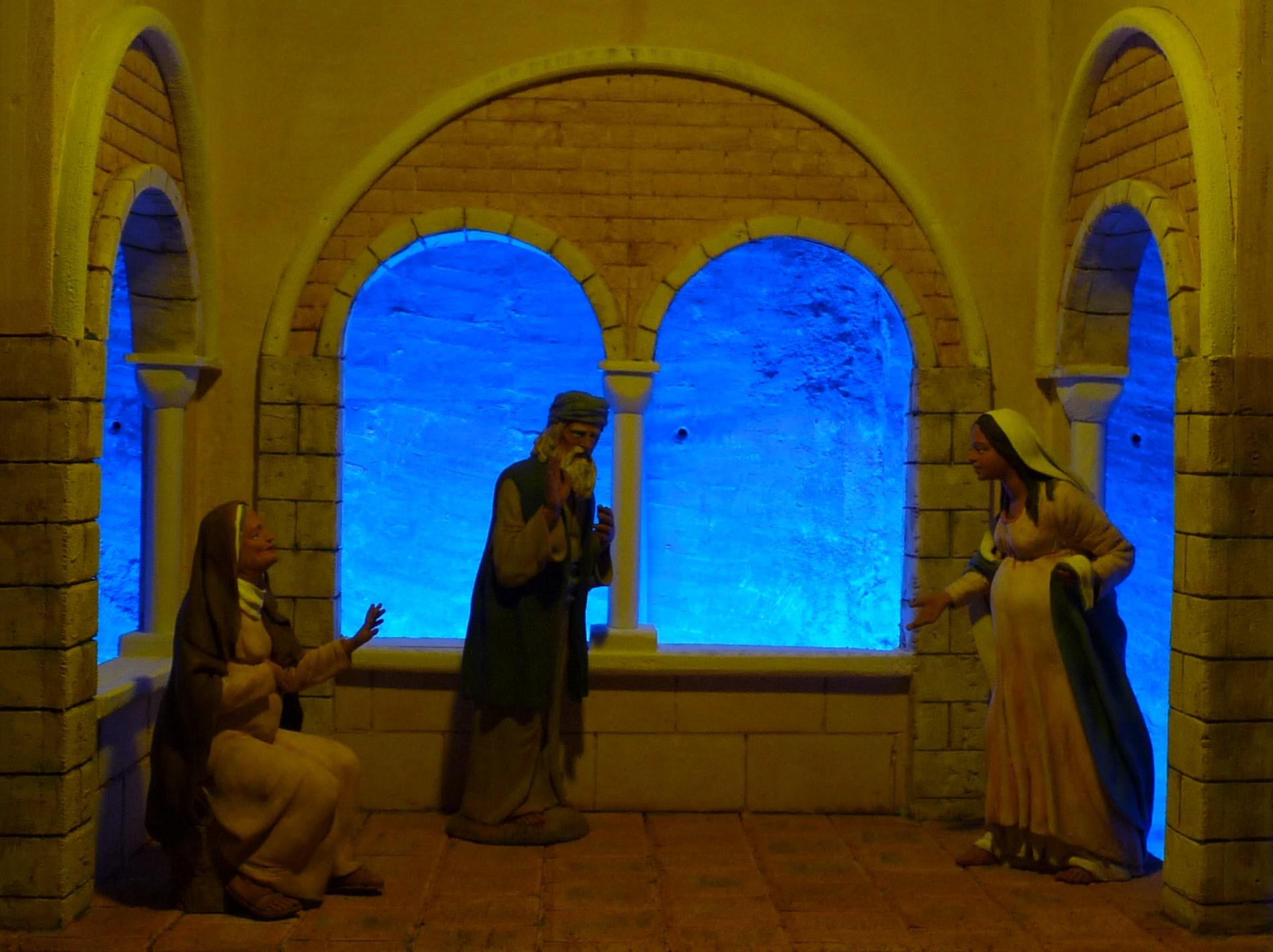
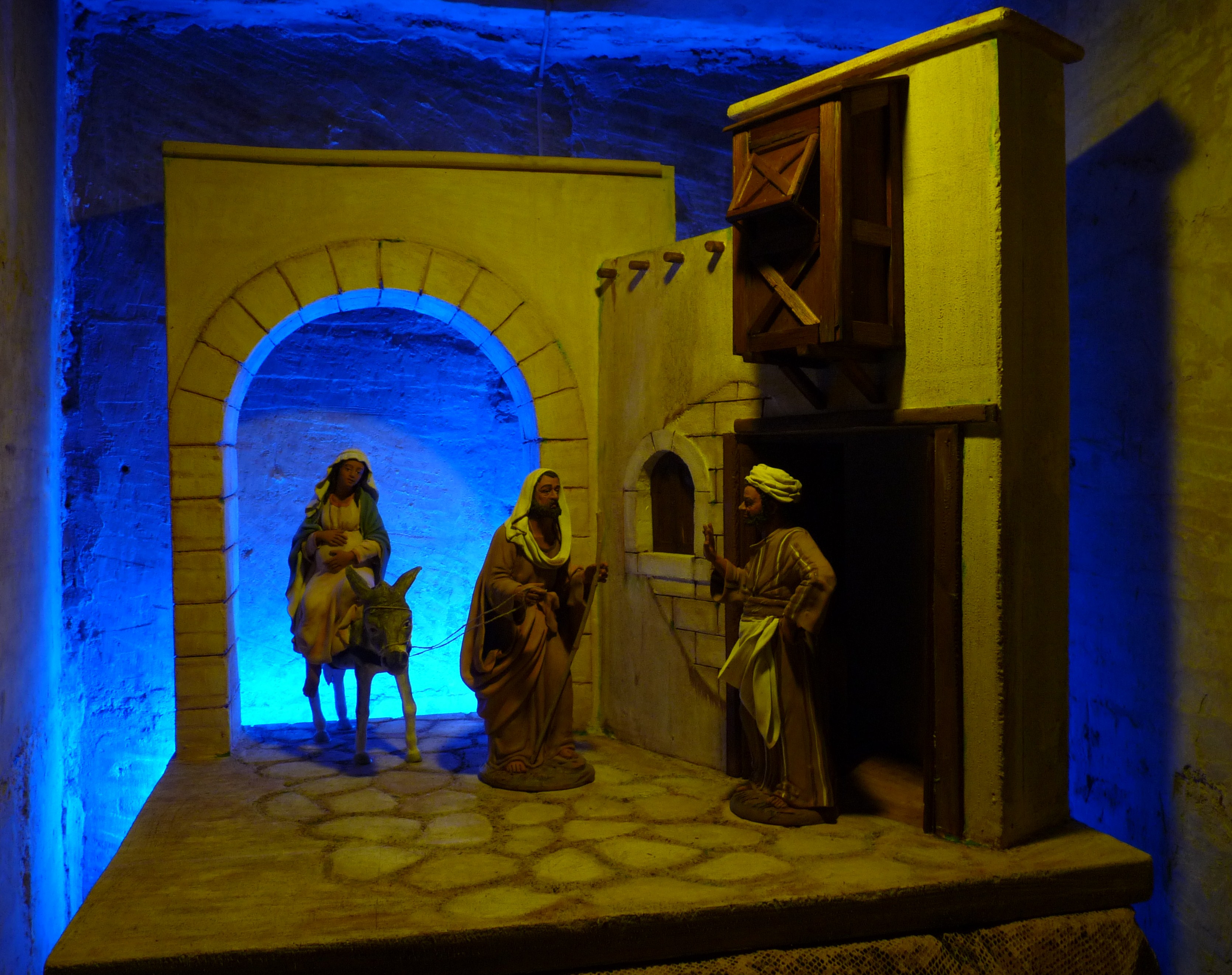
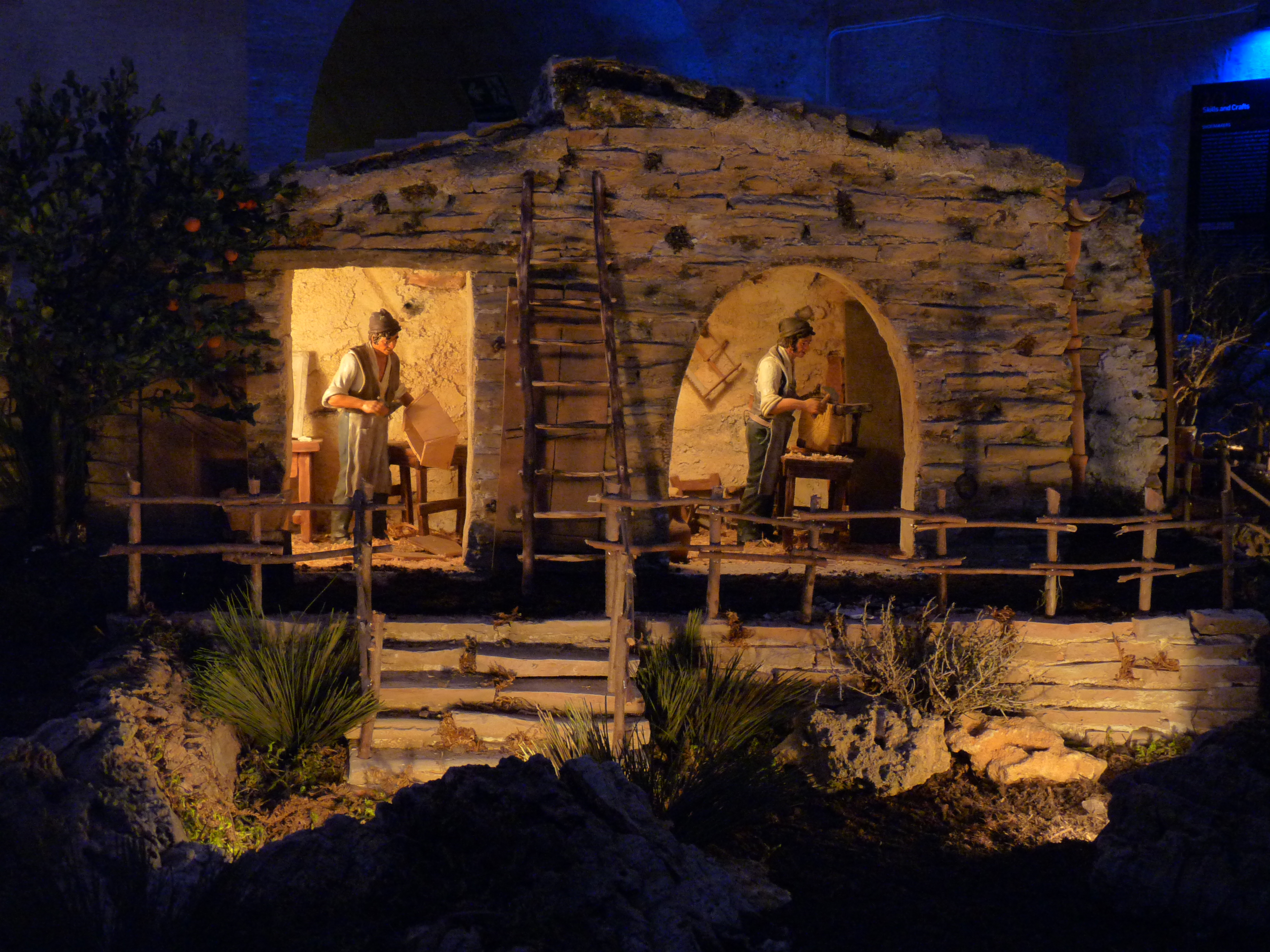
“The setting up of a crib during the Christmas season has become a worldwide tradition. However probably, few are aware that by doing this, they are reproducing a custom that was originated by St Francis D’Assisi in the 13th century,” told me Francesca Cannavò, the Curator of the Nativity Museum which is located in the crypt of St Augustine’s Church in Old Mint Street, Valletta.
“The main aim of this museum is to promote a deeper understanding and meaning regarding the nativity of Jesus and how this sacred event has been represented artistically during all these years by various artists,” explained Andrea Consalvo Rifici, the marketing manager.
Indeed, during these last months, the ambience of this huge crypt has been completely transformed into a landscape which instills the perception of being absorbed back in time, right to the period of this holy nativity.
“We want the visitors to walk around this place and to meditate about what was happenning in the days before baby Jesus was born and also what took place soon after.”
Various panels with interesting information accompany the visitors throughout this journey which takes them deep within the old crypt in search of the revelation of the Christmas story. Meanwhile, heavenly music engages the visitors and immerses them into the sanctity of this experience.
“In the old days, many of the people were uneducated and so they could not read the scriptures. Therefore, the Church set up various plays and commissioned many paintings in order to create a visual narrative with which the people could comprehend certain episodes in Jesus’ life.”
In fact, beautiful reproductions of renowned artistic works that portray the nativity scene compliment and enhance the significance of this museum, as the visitors can enjoy and absorb the different interpretations that were effected by remarkable painters such as Leonardo da Vinci, Giotto, Tiziano, Rubens, Botticelli, Carvaggio, Fra Angelico, and Hugo van der Goes.
“It is believed that these representations of the nativity have inspired St Francis of Assisi to compose the first crib which he set up in a cave. Eventually, this idea was so much appreciated by the people that they decided to produce their own cribs in order to possess the blessed nativity scene within their homes. As years passed, people continued to develop this concept by designing new ways of expressing this remarkable episode.”
A circular room within this crypt has been selected to present a set of artistic scenes which manifest the main events that are relative to the birth of Jesus; such as that of the Annunciation, the dream of Joseph, Mary’s visit to a pregnant elder Elizabeth, the search to find a place for Mary to give birth and the hasty escape to Egypt.
“These set ups have been designed in Sicily in order to decorate this museum. The figurines were made by Vincenzo Velardita in Caltagirone whereas the scenography was realized by Gigi Genovese in Catania. We tried to keep these scenes as simple as possible in order to reflect the modest nature that Jesus Himself chose for his own birthplace.”
Certainly, the principal attraction in this nativity museum is the huge crib with its numerous mechanical figures.
“This crib is the work of Salvatore Milazzo from Caltagirone. We are proud to say that it has been admired in several countries and that it has received various prestigious awards. This year, we decided to introduce it to Malta because we are aware that the Maltese people are deeply devoted to the nativity of Jesus. Moreover, we wanted to share our Sicilian culture with the Maltese people since there are many similarities between our culture and traditions.”
Milazzo’s work is definitely a work of art as it embraces within it all the skill of the renowned Caltagirone masters of this trade. The forty square metre crib has been decorated with a typical Sicilian country lansdcape of the 1800s which includes also a number of workshops of trades which do not exist any longer.
Meanwhile, this museum incorporates within it also a number of locally made cribs that were provided by members of Friends of the Crib (Malta).
Interestingly, this nativity museum which has opened its doors for the public in November will not close after the Christmas season and it will remain available to visitors all throughout the year.
“The concept behind the creation of this nativity museum in Malta is to heighten the experience of Valletta 2018 both to local and to foreign visitors, by blending together the culture of this island and that of Sicily.”
(This article was published in CHRISTMAS TIMES Magazine which was issued with The Times of Malta dated 13th December 2014)
-
Far more than walking on a winter wonderland
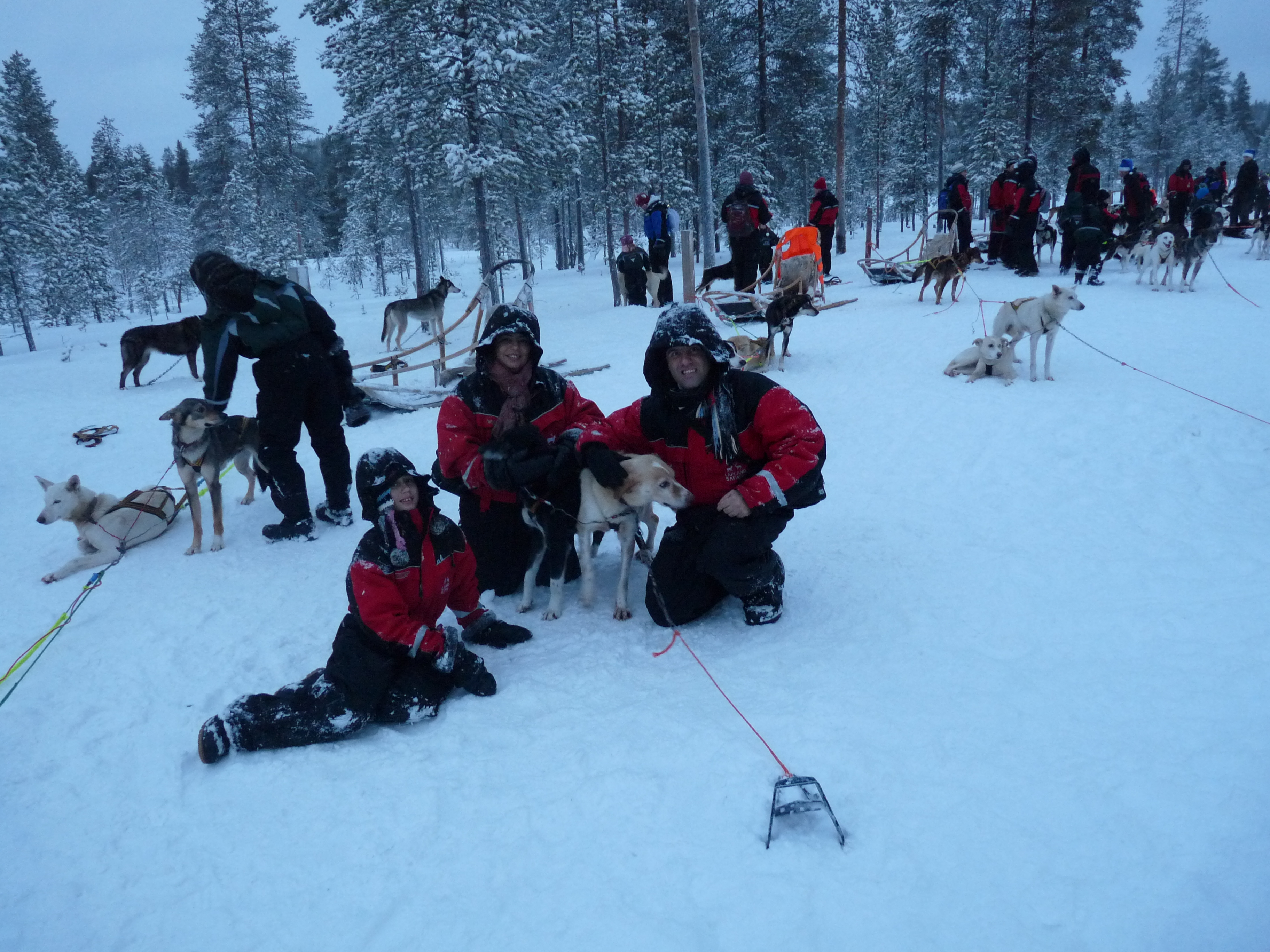
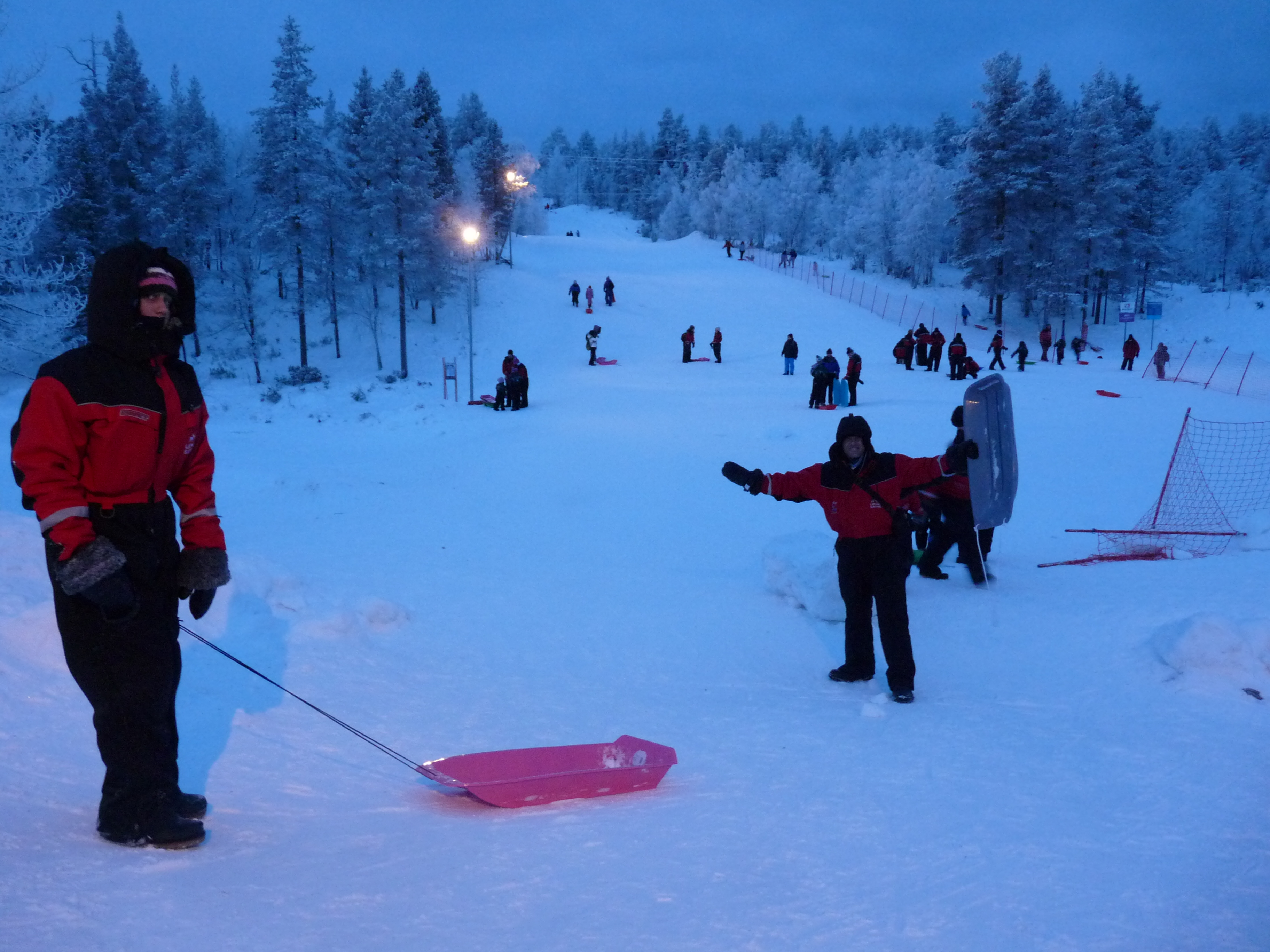
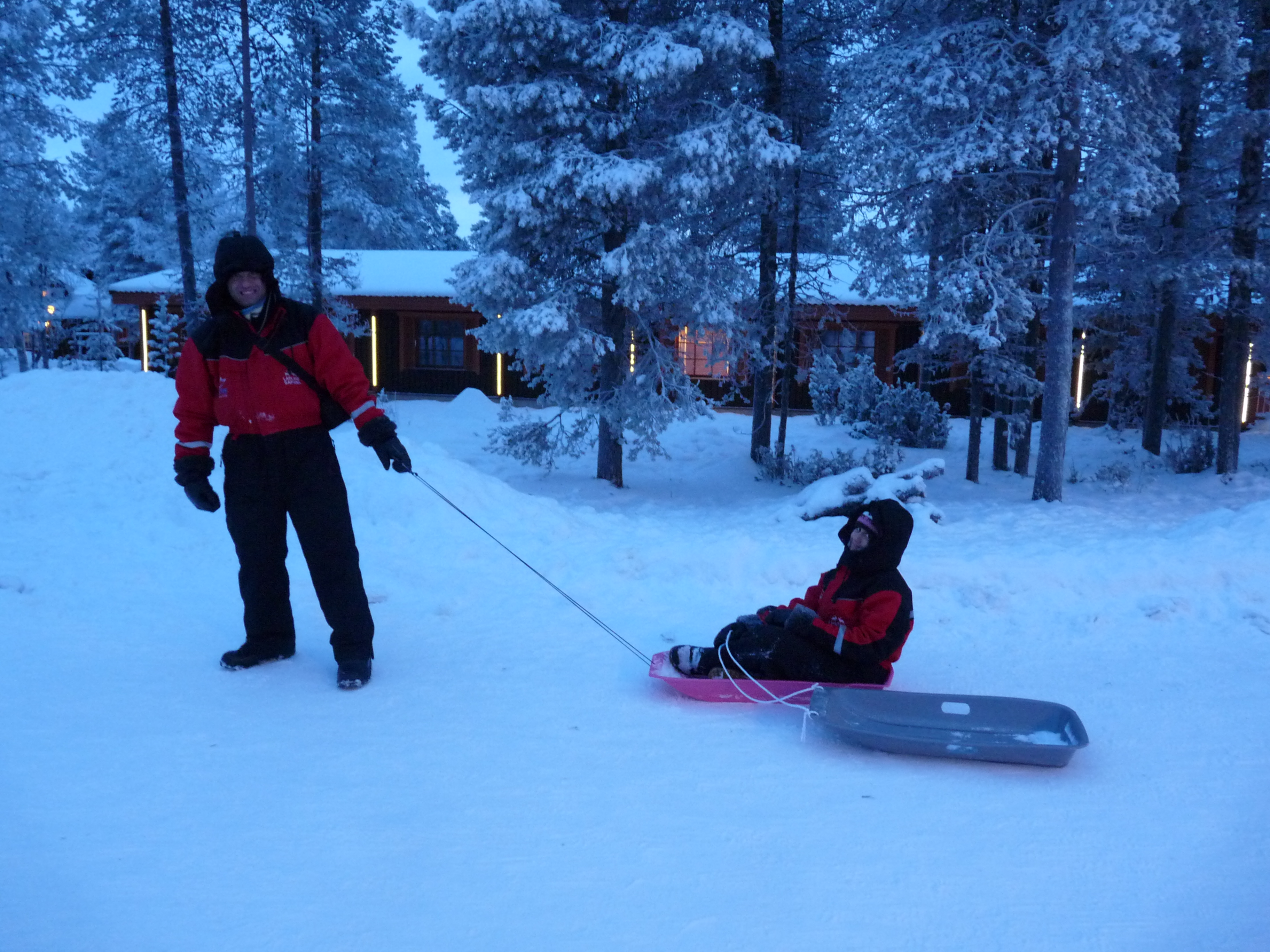

We had always wished to spend Christmas in some foreign land in order to see how this event is celebrated in other countries. Ideally this place had to be similar to the ones that we saw on Christmas cards; that is with wooden log cabins, fire-places and much much snow.
Eventually, a brilliant idea came to our mind! What if we went to visit Santa’s land itself in Lapland, Northern Finland?
Although many of us have grown up to believe that Father Christmas is just a legend, my daughter and I are sure that he is real. Well, he comes to visit us each year and he always leaves a lovely present for Martina. So surely, after ten annual visits to our home, we decided that it would be nice of us to exchange the courteousy.
That was how we found ourselves at Gatwick airport being led away from the usual crowded queues by a special officer who rang a bell in order to call for those whose destination was Ivalo airport.
Soon, several families with excited children joined the group and off we went on a charter airplane which was waiting to take us to this magical land. Everything was superb from the start, even this flight which was completely dedicated to entertain the children with enjoyable games. Then, when we were approaching land, all the children turned to the airplane’s window in order to watch for Santa’s flying sleigh. We did not succeed to see it but deep beneath the fluffy white clouds, there appeared a strange landscape of dark land, remarkably patterned with plentiful shiny rivers and lakes. So that was how the Arctic Circle looked!
Our airplane landed smoothly down at Ivalo’s minute airport in Lapland, North Finland and soon we found ourselves walking in the crunchy snow. Mischievous, brightly dressed elves slid out together with our luggage and greeted us with playful tricks, whilst a traditionally dressed Finnish Sami, who forms part of the indigenous people of this area, welcomed us to his land in the company of a large reindeer. A coach transferred us to the tourist resort in Saariselkä which was only 25 minutes away.
Since in Saariselkä, the temperature goes down well beyond zero degrees, we had to pack a couple of cosy clothes in our luggage. However, on arrival, everyone was provided with a complimentary thermal outer-suit, along with woolen socks, snow boots, outer gloves and hats, in order to guarantee a comfortable stay since there the temperature could go down to -30 degrees celcius.
There is a good choice of hotels wherein to spend this holiday: starting from Santa’s Kieppi which is built in the traditional Finnish style, and moving on to the modern style Santa’s Holiday Club which includes an indoor pool with waves and chutes. We chose to stay in Hotel Kieppi because we considered it to be more authentic. Its owner, Matti Välitalo, informed us that in Finnish, the word ‘kieppi’ referred to the burrow where animals hibernated during winter, and surely this place was warm and snug contrasting to the icy coldness outside.
Between the beginning of December and the first days of January, Saariselkä experiences the polar night as the sun does not rise. However the place does not lie in total darkness since the light of the moon, the stars, and the magnificent Northern Lights are reflected by the snow, and therefore one can move around easily at whatever time. During this period, at about ten in the morning, the dusky blue sky turns into an unusual blend of silver and blue colours which is later imbued with different hues of blue and red, until at about three in the afternoon, when it starts getting dark again. This entire ambience felt strange at first but once we got used to it, it enhanced each and every moment and turned it into a unique Christmas experience. We really felt as if we had stepped into another world.
Even the activities that we could do were extraordinary and it didn’t take very long to see the adults being transformed into joyful and happy children. It’s bound to be! For how can one resist the feeling of a true white Christmas whilst squishing or toboganning in the milky Arctic snow? We were provided with free toboganns from our hotel and Martina took the opportunity to be pulled all along the way. I have to admit that it was somewhat frightening at first because we had never experienced this sport. But when we saw very young children shooting down confidently, we walked up the small snowy hill and off we went. Oh my! It felt like flying! An amazing experience! Anyhow, we lost count how much rides we did.
Each time we travelled by coach, our guides made their utmost in order to help us feel the Christmas spirit. Once more, we found the atmosphere quite captivating as we sang heartily a couple of old Christmas songs along with people coming from various countries around the world, under a sky packed with twinkling stars.
However surely, the best moment of this holiday for each visitor, whether adult or young was the special visit to the village of Father Christmas in the Arctic Circle. Here, with activities ranging from ice fishing, toboganning, reindeer sleigh rides, snow hockey, skidoo rides, and an igloo bar, who can wish for more? Yet there was more! In fact, after providing us with the required instructions, we were offered to drive a pack of huskies in the snow. My husband controlled the huskies and my daughter and I huddled up in the sleigh wrapped up in reindeer skin. What a delight!
Still, more followed since each family, at some point or another, was secretly and quickly hurried upon a snowmobile-sled in order to search for the elves who knew how to point the way to Santa’s log cabin which was craftily hidden in the icy woods. It was a really enthralling experience to enter into the warmth of Santa’s magical hut and to find him sitting in his huge wooden chair amid a multitude of colourful presents. Martina was dumbfounded as she noticed that Santa was holding and reading her own hand-written letter which she had sent him some days ago by post from Valletta! When she found some courage, she told him that many of her friends told her that he did not exist.
“Well now you have seen that I do!” he told her warmly as he laughed heartily and gave her a beautiful teddy bear. Martina hugged Santa as if to check that she was not dreaming and she even kissed him on the cheek. Once our private meeting with Santa was over, we were taken back to the rest of the group but Martina was simply entranced by this experience.
On Christmas day, we attended a gala dinner where we discovered that in Finland, ham is the Christmas food specialty. However we were treated to a bountiful meal of different meats and fish, together with a selection of pastries and delicious wild berries.
We surely missed the company of our dear family members and the sweet presence of baby Jesus in his crib which was nowhere in sight in these locations. Yet in Saariselkä everything was designed to entertain visitors and one will absolutely not have time to feel a trace of sadness.
We spent only four days in Santa’s Lapland but the surrealism of the place mystified the aspect of time and we felt as if we belonged there. Surely no other Christmas will ever match this one.
(This article was published in the Travel Supplement of The Sunday Times of Malta dated 2nd November 2014)
-
THE NATIVITY IN MINIATURE
When the last month of the year steals its way into our hearts, we find ourselves in a world of light, colours, dreams, hopes and Christmas… and nothing symbolises the
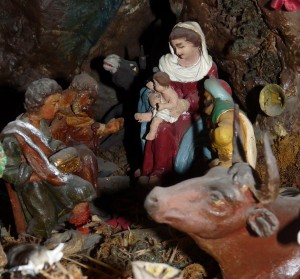 Christmas spirit better than the nativity scene captured in a traditional crib. Fiona Vella went in search of two remarkable examples of this long-standing Maltese tradition.
Christmas spirit better than the nativity scene captured in a traditional crib. Fiona Vella went in search of two remarkable examples of this long-standing Maltese tradition.As December comes round, out come the boxes loaded with colourful accessories and delights which were stored away the previous year: a disassembled Christmas tree, some intricate ornaments and a few old cherished cards.
Yet nothing compares to the allure of a precious crib with its little figurines and the statuette of baby Jesus which needs to be warmed up with Ġulbiena, at least in a country with a strong Christian
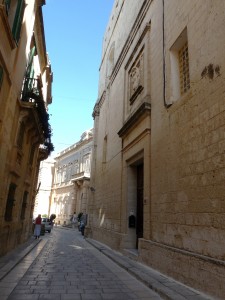 tradition like Malta. The annual ritual of setting up the crib is fascinating, but what is this enigmatic fascination which draws us each year to recreate this nativity scene? To unearth this riddle I decided to go back to our roots, seeking out two beautiful antique treasures which lie within our intriguing island.
tradition like Malta. The annual ritual of setting up the crib is fascinating, but what is this enigmatic fascination which draws us each year to recreate this nativity scene? To unearth this riddle I decided to go back to our roots, seeking out two beautiful antique treasures which lie within our intriguing island.MDINA
The first gem is situated deep in the heart of the medieval town of Mdina, shielded in the core of St Peter’s Monastery, the domicile of the Benedictine Cloistered Nuns.
With the aid of Joseph Flask, a diligent writer about the life and history of the Benedictine Monastic Order, I was allowed to meet the Rev. Mother Abbess Sr. Maria Adeodata Testaferrata de Noto OSB who received me warmly and invited me to view the oldest known static crib in Malta.
The monastery itself is a magnificent historic and architectural site, dating back to the 15th century. Nevertheless the experience of stepping inside a location which is customarily prohibited to
 outsiders’ eyes took that sense of magnificence one step further.
outsiders’ eyes took that sense of magnificence one step further.Up the stairs and along the innermost corridors, lying dormant behind a wide glass case and heavy curtains was my ‘prize’, and I was overwhelmed with emotion as I beheld this rarely seen fine example of one of the highest Maltese traditions.
No one knows who was its original creator or when it was built, but probably the crib’s first restoration took place in 1826, as the earliest painted signature G.B.G
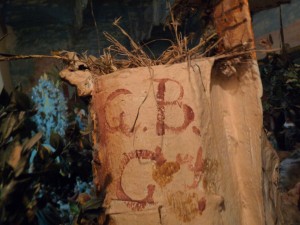 indicates. A similar unspecified restorer enlarged the crib in 1846 and left a simple mark of G.G. A final revamp dates back to 1977, this time clearly signed by Giuseppe Sammut who painted and added the crib’s scenery.
indicates. A similar unspecified restorer enlarged the crib in 1846 and left a simple mark of G.G. A final revamp dates back to 1977, this time clearly signed by Giuseppe Sammut who painted and added the crib’s scenery.Incredibly, while we were exploring the crib, we chanced upon another signature which Joseph had never noticed before – a coarse reddish scribbling bearing the initials G.G and a not so clear G.I. Evidently the crib seems to hold even more challenges and clues for devotees to decipher.
The crib is embedded with personal memories of several people. In fact, a closer glimpse at its figurines lying around the
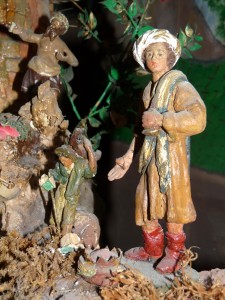 unrefined landscape made of glued old sacks and newspapers, reveals that oddly most of the figures do not match each other, either in style, age or even size! This effect was initiated by the nuns themselves when they resolved to bestow the original crib’s population with every relative statuette that came in their possession! Amusingly, more intense exploration discloses even extraneous insertions; such as the Greek classic statuette and an irrelevant building situated at the back. Peculiar as it might seem, this reality exudes a tender feeling as one realizes that the crib actually encompasses the love and memories of each nun that lived with it.
unrefined landscape made of glued old sacks and newspapers, reveals that oddly most of the figures do not match each other, either in style, age or even size! This effect was initiated by the nuns themselves when they resolved to bestow the original crib’s population with every relative statuette that came in their possession! Amusingly, more intense exploration discloses even extraneous insertions; such as the Greek classic statuette and an irrelevant building situated at the back. Peculiar as it might seem, this reality exudes a tender feeling as one realizes that the crib actually encompasses the love and memories of each nun that lived with it.The crib is in fact of somewhat crucial help to the cloistered nuns, helping them to evoke the
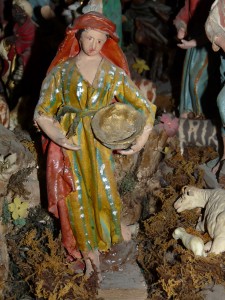 meaning behind the holy birth; a tangible item in a life withdrawn from the usual worldly pleasures, which constantly reminds them of the sweet joy of Christmas. Indeed, this very crib inspired the renowned short writings of the Blessed Maria Adeodata Pisani OSB who lived in the monastery for several years. And to this day, the crib continues to instigate the spirits of the other nuns when on Christmas Eve they celebrate a traditional procession which ends up in front of it.
meaning behind the holy birth; a tangible item in a life withdrawn from the usual worldly pleasures, which constantly reminds them of the sweet joy of Christmas. Indeed, this very crib inspired the renowned short writings of the Blessed Maria Adeodata Pisani OSB who lived in the monastery for several years. And to this day, the crib continues to instigate the spirits of the other nuns when on Christmas Eve they celebrate a traditional procession which ends up in front of it.ŻEJTUN
The other route to discovery led me to the quaint village of Żejtun, again to another convent but this time to see the oldest, large, Maltese mechanical crib, which dates back to 1945, a period wherein
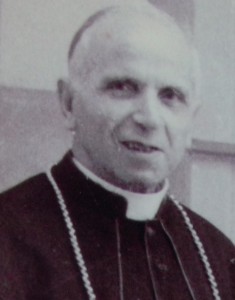 our island lay ravaged from the destruction of World War II. It was this devastation that inspired Mons. Emmanuel Galea to create a unique religious symbol as he saw that people desperately needed to rekindle their faith and hope of a better life.
our island lay ravaged from the destruction of World War II. It was this devastation that inspired Mons. Emmanuel Galea to create a unique religious symbol as he saw that people desperately needed to rekindle their faith and hope of a better life.Together with his nephew Pawlu Pavia he devised a plan to build a large mechanical crib which could be motor-driven.
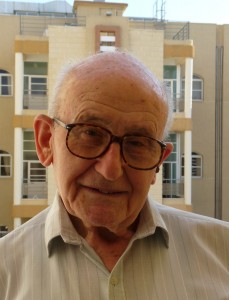
I found Pawlu, now 86, residing in St Vincent De Paule’s residence. Despite his old age, he reconstructed the whole story with sharp clarity and also with a touch of melancholy.
He remembers how some workers were brought in to build a platform made from random pieces of broken doors and windows. Moreover, three openings were cut in one of the room’s wall as the crib
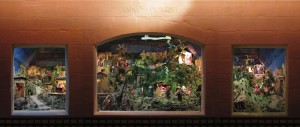 had to represent three sections: what happened before the birth of Jesus Christ, the actual birth itself and what occurred thereafter.
had to represent three sections: what happened before the birth of Jesus Christ, the actual birth itself and what occurred thereafter.The fabrication of papier machè and the layout of the crib he made with the bishop, while he alone was responsible for building the crib’s figurines from wood and iron wire. However the hardest task
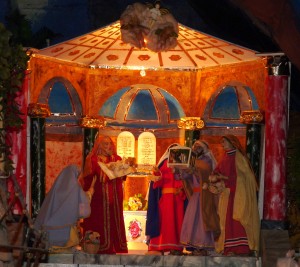 was to find some ingenious way of motorizing the figurines’ movements and to actually interelate them at a time when resources were very few. Another difficulty was to surpass the dilemma of an unstable electric current. Incredibly he did all this by means of one single motor which he succeeded to find in a remote shop. Even more incredible is that after 65 years, the crib still functions with this same system!
was to find some ingenious way of motorizing the figurines’ movements and to actually interelate them at a time when resources were very few. Another difficulty was to surpass the dilemma of an unstable electric current. Incredibly he did all this by means of one single motor which he succeeded to find in a remote shop. Even more incredible is that after 65 years, the crib still functions with this same system!This journey also led me to Sister Pawlina Gauci, now 78, who, together with the late Sr. Angela, had the responsibility of dressing the figures. Her three years
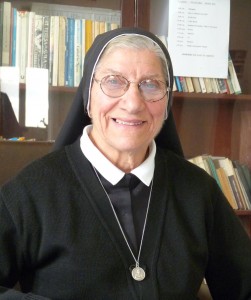 missionary work in Persia (now Iran) aided her with good knowledge of the type of material to be used and one by one the figures were clothed with several samples of fabric which a number of shops had contributed.
missionary work in Persia (now Iran) aided her with good knowledge of the type of material to be used and one by one the figures were clothed with several samples of fabric which a number of shops had contributed.Both Pawlu and Sr. Pawlina recall the commotion that this crib raised when it was opened to the public for the first time during Christmas of 1947. Visitors came from all over Malta and there was such a big crowd that the police had to intervene to keep control of the situation!
Now that Pawlu is retired, the crib passed into the care of his nephew Joseph Pavia,
 whose great dedication to it is no lesser than his uncle’s. In fact during the last years Joseph renovated the visitors’ room and included a very interesting documentary which recounts the whole story of this crib in five different languages.
whose great dedication to it is no lesser than his uncle’s. In fact during the last years Joseph renovated the visitors’ room and included a very interesting documentary which recounts the whole story of this crib in five different languages.Remarkably, even this crib seems to bear the destiny to be associated with holiness as currently there is the process of the cause for canonization of its instigator, Mons. Emmanuel Galea.
As I left the crib, I pondered about the dedication and devotion behind their creation. The endeavour, the ritual, the almost childish happiness to share a crib with others… all lead to an ancient dream
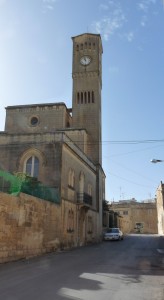 which St Francis of Assisi had foreseen a long time ago in the village of Greccio. For through its modesty, a crib reminds us that the spirit of Christmas is simple and that it is meant to reach out to our hearts and souls and bathe them in the joy of the birth of Jesus.
which St Francis of Assisi had foreseen a long time ago in the village of Greccio. For through its modesty, a crib reminds us that the spirit of Christmas is simple and that it is meant to reach out to our hearts and souls and bathe them in the joy of the birth of Jesus.(This article was published in FIRST magazine, Issue December 2010. FIRST magazine is delivered with The Malta Independent on Sunday)
Travelogue
Archives
| M | T | W | T | F | S | S |
|---|---|---|---|---|---|---|
| « Jan | ||||||
| 1 | 2 | 3 | 4 | 5 | 6 | 7 |
| 8 | 9 | 10 | 11 | 12 | 13 | 14 |
| 15 | 16 | 17 | 18 | 19 | 20 | 21 |
| 22 | 23 | 24 | 25 | 26 | 27 | 28 |
| 29 | 30 | |||||
Recent Posts
- A MATTER OF FATE
- MALTA’S PREHISTORIC TREASURES
- THE MAGIC IS IN THE DETAIL
- THE SELLING GAME
- NEVER FORGOTTEN
- Ġrajjiet mhux mitmuma – 35 sena mit-Traġedja tal-Patrol Boat C23
- AN UNEXPECTED VISIT
- THE SISTERS OF THE CRIB
Comments
- Pauline Harkins on Novella – Li kieku stajt!
- admin on IL-KARNIVAL TRAĠIKU TAL-1823
- Albert on IL-KARNIVAL TRAĠIKU TAL-1823
- Martin Ratcliffe on Love in the time of war
- admin on 24 SENA ILU: IT-TRAĠEDJA TAL-PATROL BOAT C23